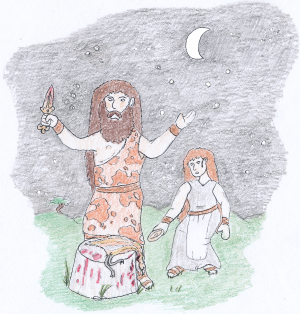Cult of Erkar
Erkar is one of the main deities in Mörkel mythology, specifically the Eilatogían Tradition, which originated in Eila'togía, the earliest kingdom on the Plain of Kings where many common features of Mörkel culture developed during the second century a.Dr.
Erkar is regarded as the strongest of the gods as well as the most destructive, able and eager to unleash wild beasts, tumultuous seas and all kinds of calamities on mortals whenever they don't show the gods enough respect. In early Mörkel traditions, Erkar shared a number of traits with the sun god Aþar, to the point the two were worshipped as two aspects of the same deity, and many early chiefs and kings traced their lineage to him.
Over time, as life became more civilized and especially since the Dragon disappeared, Erkar's role has shifted to being associated with stone and the sea, while Aþar has replaced him as the protector of royal dynasties.
The gods tolerate Erkar's destructive nature due to him being one of the few who can keep the silver giants and other beings from taking over the world.
Erkar is regarded as the strongest of the gods as well as the most destructive, able and eager to unleash wild beasts, tumultuous seas and all kinds of calamities on mortals whenever they don't show the gods enough respect. In early Mörkel traditions, Erkar shared a number of traits with the sun god Aþar, to the point the two were worshipped as two aspects of the same deity, and many early chiefs and kings traced their lineage to him.
Over time, as life became more civilized and especially since the Dragon disappeared, Erkar's role has shifted to being associated with stone and the sea, while Aþar has replaced him as the protector of royal dynasties.
Rituals
Like the war goddess Datena, ceremonies associated with Erkar are primarily to placate him rather than invoke, and are often held at night outside settlements. His priests and priestesses, in stark contrast to those devoted to other deities, are unkempt and wear either animal skins or tattered clothes to emphasize how the deity is believed to regard mortals; as lowly beings created solely for providing the gods with offerings, praise and amusement. Priest and priestess of Erkar offering a bird to the god.Mythology
In Eilatogían Tradition, Erkar is counted as one one of the five primordial deities created the world, and is credited for shaping the hills, mountains and boulders. He was the first of the gods to take up arms against the silver giants, who had been created to bring light into the world and eventually revolted, and in some later versions was involved in creating the Dragon, either to punish mortals for hubris or simply because he thought they were too prosperous.The gods tolerate Erkar's destructive nature due to him being one of the few who can keep the silver giants and other beings from taking over the world.




Comments